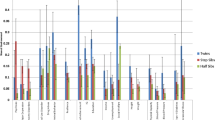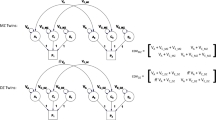Abstract
This study explores power assumptions relating to extended pedigree designs (EPD) and classical twin designs (CTD). We conducted statistical analyses to compare the power of the two designs for examining neuroimaging phenotypes, varying heritability and varying whether shared environmental variance is fixed or free. Results indicated that CTDs have more power to estimate heritability, with the exception of one condition: in EPDs, the power increases relative to CTDs when shared environmental variance contributes to sibling similarity only. We additionally show that assuming a priori that shared environmental effects play no role in a phenotype—as is commonly done in pedigree designs—can lead to substantially biased heritability estimates. General results indicate that both CTDs and EPDs obtain quite precise heritability estimates. Finally, we discuss methodological considerations relating to assumptions about age effects and shared environment.
Similar content being viewed by others
Notes
Numbers do not total to 100% due to rounding error.
References
Blangero J, Williams JT, Almasy L (2003) Novel family-based approaches to genetic risk in thrombosis. J Thromb Haemost 1:1391–1397
Carey G (2003) Human genetics for the social sciences. Sage Publications, Thousand Oaks
Chen CH, Fiecas M, Gutierrez ED, Panizzon MS, Eyler LT et al (2013) Genetic topography of brain morphology. Proc Natl Acad Sci USA 110:17089–17094
Coon H, Carey G (1989) Genetic and environmental determinants of musical ability in twins. Behav Genet 19:183–193
Dolan CV, Boomsma DI, Neale MC (1999) A note on the power provided by sibships of sizes 2, 3, and 4 in genetic covariance modeling of a codominant QTL. Behav Genet 29:163–170
Eaves LJ, Heath A, Martin N, Maes H, Neale M et al (1999) Comparing the biological and cultural inheritance of personality and social attitudes in the Virginia 30000 study of twins and their relatives. Twin Res. 2:62–80
Glahn DC, Winkler AM, Kochunov P, Almasy L, Duggirala R et al (2010) Genetic control over the resting brain. Proc Natl Acad Sci USA 107:1223–1228
Heath AC, Berg K, Eaves LJ, Solaas MH, Corey LA et al (1985) Educational policy and the heritability of educational attainment. Nature 314:734–736
Heath AC, Cates R, Martin NG, Meyer J, Hewitt JK et al (1993) Genetic contribution to risk of smoking initiation: comparisons across birth cohorts and across cultures. J Subst Abuse 5:221–246
Keller MC, Medland SE, Duncan LE, Hatemi PK, Neale MC et al (2009) Modeling extended twin family data I: description of the Cascade model. Twin Res. and Hum. Genet. 12:8–18
Keller MC, Medland SE, Duncan LE (2010) Are extended twin family designs worth the trouble? A comparison of the bias, precision, and accuracy of parameters estimated in four twin family models. Behav Genet 40:377–393
Kendler KS, Neale MC (2009) “Familiality” or heritability (letter to the editor). Arch Gen Psychiatry 66:452–453
Kendler KS, Neale MC, Heath AC, Kessler RC, Eaves LJ (1994) A twin-family study of alcoholism in women. Am J Psychiatry 151:707–715
Kendler KS, Neale MC, Kessler RC, Heath AC, Eaves LJ (1993) A test of the equal-environment assumption in twin studies of psychiatric illness. Behav Genet 23:21–27
Kendler KS, Neale MC, Sullivan P, Corey LA, Gardner CO et al (1999) A population-based twin study in women of smoking initiation and nicotine dependence. Psychol Med 29:299–308
Kremen WS, Prom-Wormley E, Panizzon MS, Eyler LT, Fischl B et al (2010) Genetic and environmental influences on the size of specific brain regions in midlife: the VETSA MRI study. Neuroimage 49:1213–1223
Lango Allen H, Estrada K, Lettre G, Berndt SI, Weedon MN et al (2010) Hundreds of variants clustered in genomic loci and biological pathways affect human height. Nature 467:832–838
Loehlin JC, Nichols RC (1976) Heredity, environment and personality: a study of 850 sets of twins. University of Texas Press, Austin
Maes HH, Neale MC, Medland SE, Keller MC, Martin NG et al (2009) Flexible Mx specification of various extended twin kinship designs. Twin Res Human Genet 12:26–34
Manolio TA, Collins FS, Cox NJ, Goldstein DB, Hindorff LA et al (2009) Finding the missing heritability of complex diseases. Nature 461:747–753
Martin NG, Eaves LJ (1977) The genetical analysis of covariance structure. Heredity 38:79–95
Martin N, Boomsma D, Machin G (1997) A twin-pronged attack on complex traits. Nat Genet. 17:387–392
Neale MC, Cardon LR (1992) Methodology for genetic studies of twins and families. Kluwer Academic Publishers, Dordrecht
Neale MC, Boker SM, Xie G, Maes HH (2004) Mx: Statistical Modeling, 6th edn. Department of Psychiatry, Medical College of Virginia, Richmond
Posthuma D, Boomsma DI (2000) A note on the statistical power in extended twin designs. Behav Genet 30:147–158
Satorra A, Saris WE (1985) Power of the likelihood ratio test in covariance structure analysis. Psychometrika 54:131–151
Schork NJ, Schork MA (1993) The relative efficiency and power of small-pedigree studies of the heritability of a quantitative trait. Hum Hered 43:1–11
Souto JC, Almasy L, Borrell M, Gari M, Martinez E et al (2000) Genetic determinants of hemostasis phenotypes in Spanish families. Circulation 101:1546–1551
Truett KR, Eaves LJ, Walters EE, Heath AC, Hewitt JK et al (1994) A model system for analysis of family resemblance in extended kinships of twins. Behav Genet 24:35–49
van der Sluis S, Dolan CV, Neale MC, Posthuma D (2008) Power calculations using exact data simulation: a useful tool for genetic study designs. Behav Genet 38:202–211
Verhulst B, Eaves LJ, Neale MC (2014) Moderating the covariance between family members’ substance use behavior. Behav Genet 44:337–346
Visscher PM (2004) Power of the classical twin design revisited. Twin Res. 7:505–512
Visscher P, Hill WG, Wray NR et al (2008) Heritability in the genomics era—concepts and misconceptions. Nat Rev Genet 9:255–266
Visscher PM, Yang J, Goddard MEA et al (2010) A commentary on ‘common SNPs explain a large proportion of the heritability for human height’ by Yang et al (2010). Twin Res Human Genet 13:517–524
Williams JT, Blangero J (1999) Power of variance component linkage analysis to detect quantitative trait loci. Ann Hum Genet 63:545–563
Winkler AM, Kochunov P, Blangero J, Almasy L, Zilles K et al (2009) Cortical thickness or grey matter volume? The importance of selecting the phenotype for imaging genetics studies. Neuroimage 53(3):1135–1146
Yang J, Benyamin B, McEvoy BP, Gordon S, Henders AK et al (2010) Common SNPs explain a large proportion of the heritability for human height. Nat Genet 42:565–569
Acknowledgments
This work was supported by National Institute on Aging (AG022381, AG018384, AG018386, AG022982); National Center for Research Resources (P41-RR14075; NCRR BIRN Morphometric Project BIRN002); National Institute for Biomedical Imaging and Bioengineering (R01EB006758); National Institute for Neurological Disorders and Stroke (R01 NS052585-01); Mental Illness and Neuroscience Discovery (MIND) Institute, part of the National Alliance for Medical Image Computing (NAMIC), funded by the National Institutes of Health through the NIH Roadmap for Medical Research, Grant U54 EB005149. Additional support was provided by The Autism and Dyslexia Project funded by the Ellison Medical Foundation. The U.S. Department of Veterans Affairs has provided financial support for the development and maintenance of the Vietnam Era Twin (VET) Registry. Numerous organizations have provided invaluable assistance in the conduct of this study, including: Department of Defense; National Personnel Records Center, National Archives and Records Administration; Internal Revenue Service; National Opinion Research Center; National Research Council, National Academy of Sciences; the Institute for Survey Research, Temple University. Most importantly, the authors gratefully acknowledge the continued cooperation and participation of the members of the VET Registry and their families. Without their contribution this research would not have been possible.
Conflict of interest
Anna R. Docherty, William S. Kremen, Matthew S. Panizzon, Elizabeth C. Prom-Wormley, Carol E. Franz, Michael J. Lyons, Lindon J. Eaves and Michael C. Neale declare that they have no conflicts of interest to declare.
Human and Animal Rights and Informed Consent
This article does not contain any studies with human participants or animals performed by any of the authors. Informed consent does not apply.
Author information
Authors and Affiliations
Corresponding author
Additional information
Edited by Matt McGue.
Electronic supplementary material
Below is the link to the electronic supplementary material.
Rights and permissions
About this article
Cite this article
Docherty, A.R., Kremen, W.S., Panizzon, M.S. et al. Comparison of Twin and Extended Pedigree Designs for Obtaining Heritability Estimates. Behav Genet 45, 461–466 (2015). https://doi.org/10.1007/s10519-015-9720-z
Received:
Accepted:
Published:
Issue Date:
DOI: https://doi.org/10.1007/s10519-015-9720-z




